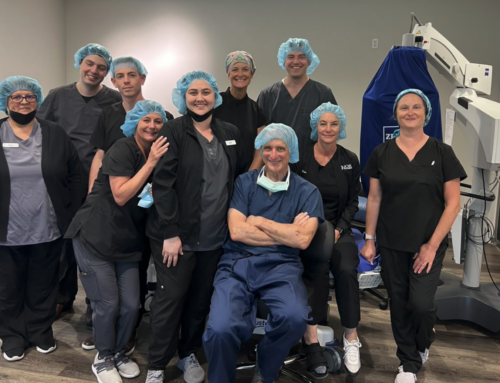
Sjögren’s (prounounced “SHOW-grins”) syndrome is an autoimmune disease, where the body’s white blood cells attack healthy tissue and organs. With this disease, the immune system attacks, among many other things, the glands that keep our eyes and mouth lubricated. This is why dry eyes are very common with Sjögren’s syndrome.
Sjögren’s syndrome is a common autoimmune disease, and it may sometimes be detected during a comprehensive eye exam. Nine out of 10 people who have it are women between 40 and 60 years old. However, it can affect men and women of any age or race.
Symptoms of Sjögren’s syndrome
Eye-related symptoms of Sjögren’s syndrome include:
- Very dry eyes
- Blurry vision
- Burning or stinging eyes
- A gritty feeling in the eye
- Being very sensitive to light
- Discomfort wearing contact lenses
- Blepharitis (inflamed eyelid margins)
- Other common symptoms include dry mouth and pain in your joints.
Diagnosis
Your eye doctor may do some tests to confirm that you have Sjögren’s syndrome. One test is called a Schirmer’s test. This is where a tiny strip of paper is placed under your lower eyelid to measure the amount of tears your eye makes over a period of about five minutes.
A dye test may be used to color your tears. This allows your doctor to see with a microscope how quickly your tears dry up. It can also help your eye doctor see how dryness has affected your cornea or other parts of the eye.
Your eye doctor may examine tiny glands in your eyelids. These glands, called meibomian (“my-BOH-me-un”) glands, produce oil for your tears to help keep them from drying out too quickly. If these glands are swollen or blocked, your tears may not have the right amount or quality of oil. This is one cause of dry eye.
Other types of tests may be done to help your eye doctor confirm Sjögren’s syndrome. For instance, they may measure how much saliva you have in your mouth. Your eye doctor also may order blood tests. This helps to check for certain proteins called antibodies and other blood markers usually found in people with Sjögren’s syndrome.
If needed, your ophthalmologist may refer you to a rheumatologist, a doctor who specializes in autoimmune disease. The rheumatologist will review the blood tests, and may help with treatment.
Treatment
It is important to treat the ongoing dry eye of Sjögren’s syndrome. Otherwise, your eyes will remain irritated and very uncomfortable. In rare cases, they can become infected and scarred, affecting your vision.
Your eye doctor may recommend you use lubricating eye drops or ointments. These drops are important in keeping your tears from drying out too quickly. That way your eyes will stay moist longer.
There are other eyedrop medicines your doctor may prescribe. In some cases, drugs to treat autoimmune disorders may also be prescribed that will help improve the dryness.
If you have a problem with your meibomian glands (called meibomian gland dysfunction, or MGD), your doctor will treat this. Treating MGD will help your tears function properly.
To can help keep your eyes moist by:
- remembering to drink plenty of water
- using artificial tears and ointments as often as your eye doctor recommends
- using a humidifier in your home if the air is very dry
- telling your eye doctor about any medicines you are taking (including allergy medicine), as they may cause dryness
 Our practice philosophy at Barth Vision & Optical is simple, though we like to think it reflects a profound sentiment. We are here to be of service, in the truest sense of the term. We offer State-of-the-art eye examinations, A unique collection of fashion eye wear, Cataract surgery & consultation, LASIK vision correction, Eye Care Telemedicine. Call Today for an Appointment (707) 955-1120.
Our practice philosophy at Barth Vision & Optical is simple, though we like to think it reflects a profound sentiment. We are here to be of service, in the truest sense of the term. We offer State-of-the-art eye examinations, A unique collection of fashion eye wear, Cataract surgery & consultation, LASIK vision correction, Eye Care Telemedicine. Call Today for an Appointment (707) 955-1120.


